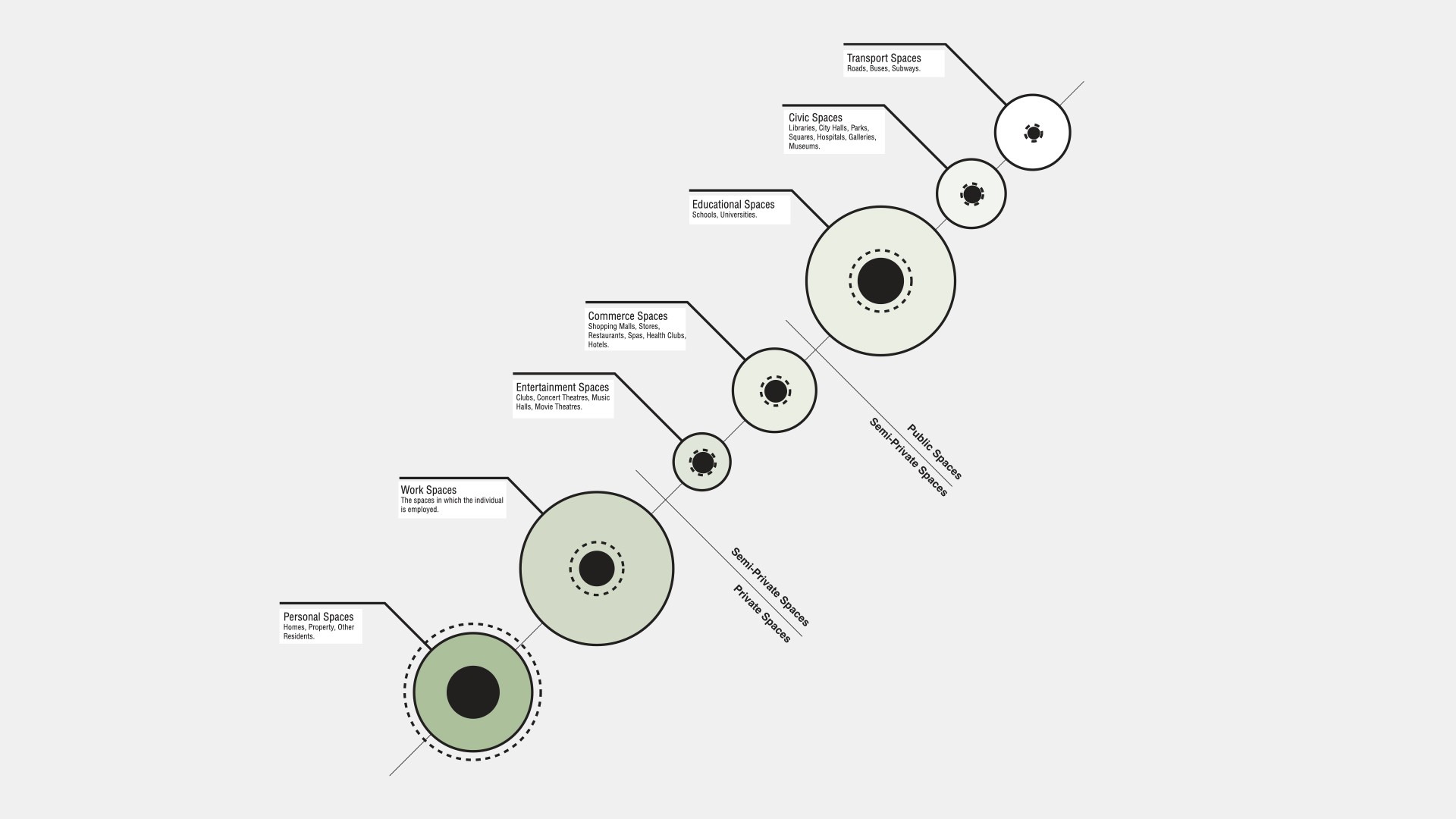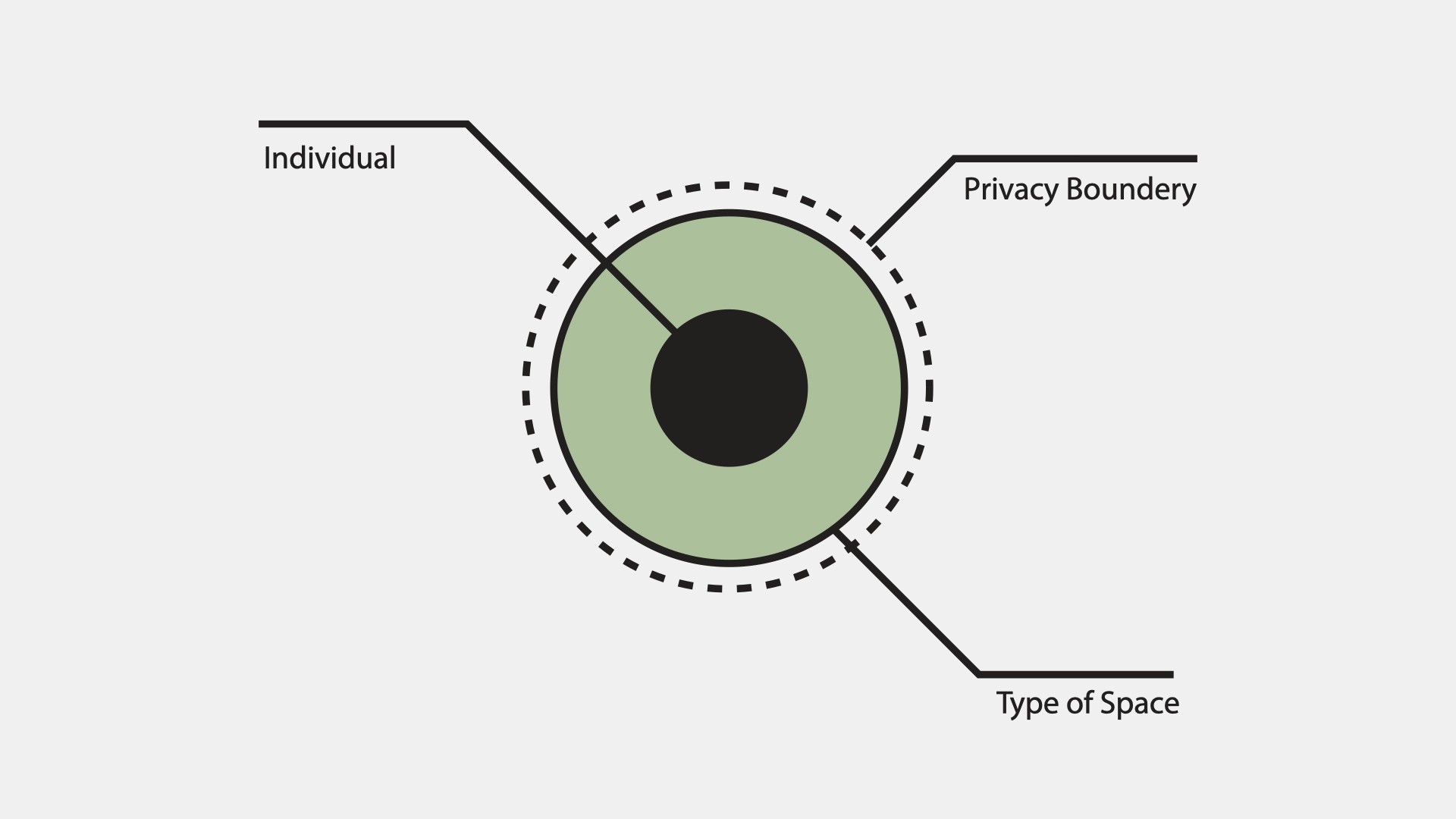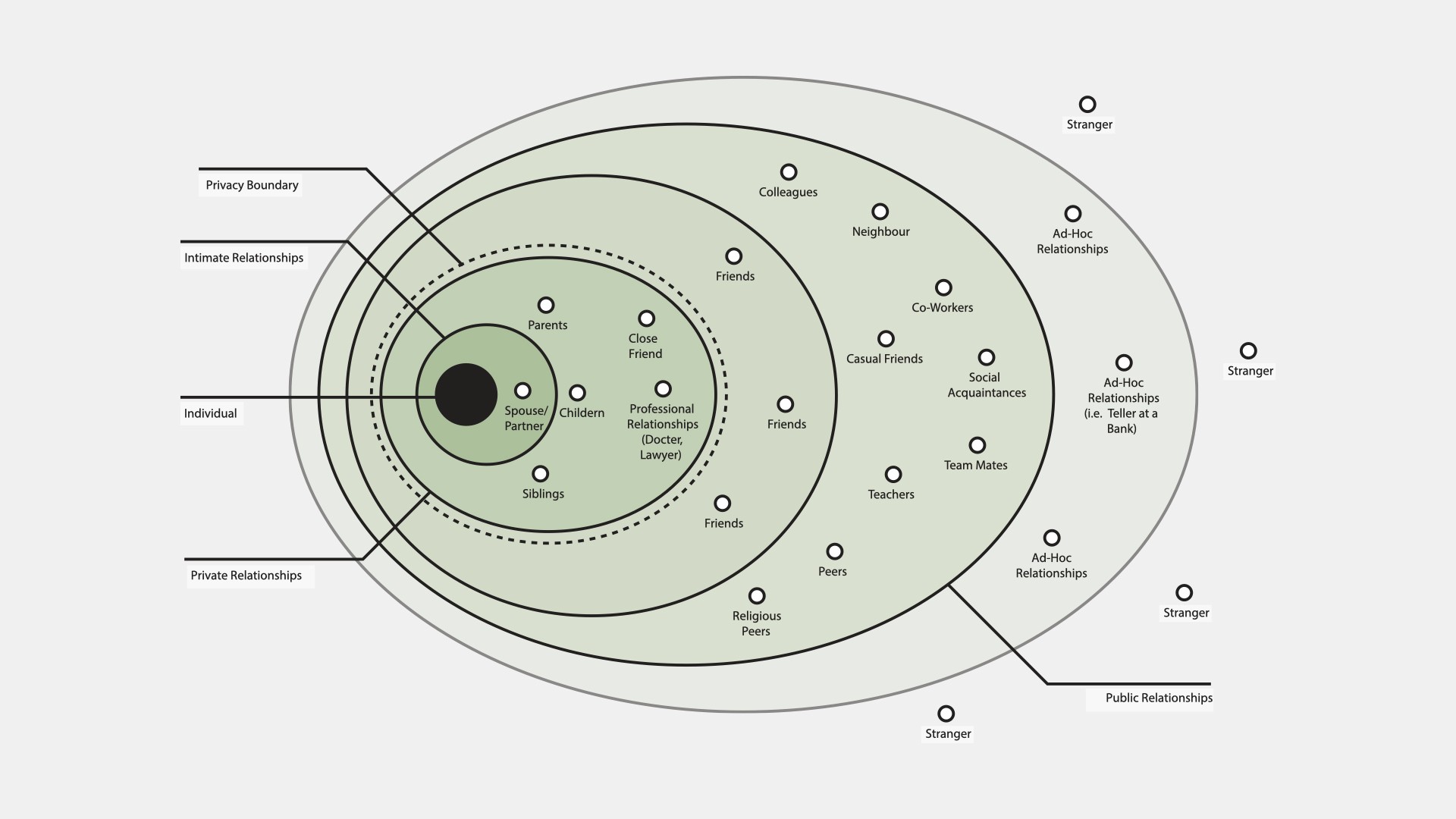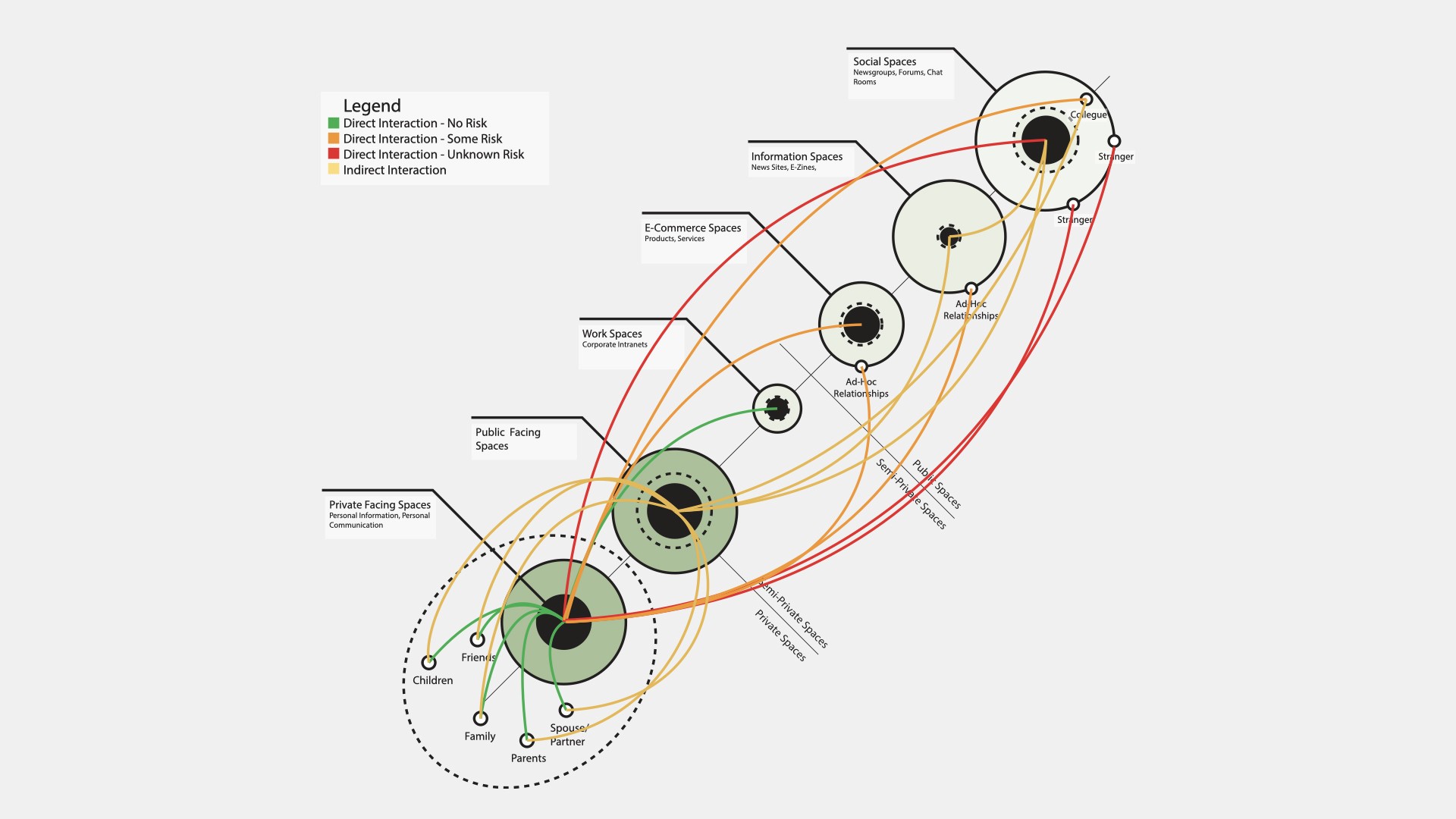Form Follows ? At the edge of Social
CGEO 609 - Geography of Cyberspace
Date
Category
Author
How the analog world shaped our online experiences.
A Visual mapping of the Form and Function of an Individuals Space and Relationships as it is impacted by the Internet
Reprinted from : April 2006 - CGEO 609 - Geography of Cyberspace
Forward
This paper was created prior the advent of social networks like Facebook & Google+. During this time online identity and communication occurred through forums, ICQ, IRC, MSN Chat & chat rooms. This paper has been critical in shaping my thinking around topics such as IOT, Architecture and Social networks. - Sanjiv Sirpal 12/2012
Introduction
When the first consumer computer was created it faced a monumental challenge. How was it supposed to connect such an abstract concept (ones and zeros) to the people that would benefit it the most? The first widely accepted operating system answered the question by being designed so that it would leverage a user’s understanding of their real world. A Graphical User Interface (GUI) was devised to visualize and connect to the brains most powerful feature – a highly sophisticated pattern recognition device. The use of metaphors allowed the computer to leverage on a users common understanding of the real world. These new computers would store ‘documents’ and ‘files’ into ‘folders’, and in turn these folders were kept in ‘filing cabinets’. These were common constructs and idea’s that people could easily relate to. It made sense, because it took the real world and placed it ‘within’ the computer
Fast forward 25 years and now at this point in time, the reverse is happening. The internet has begun to influence the way we do and understand things in the real world. Or has it? This radical technology has had a tremendous influence on how we gather and information, how we communicate and relate to each other, how social relationships are being created augmented, and how the physical form of our built environment is being evolved.
Marshall McLuhan’s famous quote that the ‘Media is the Message’, states that content is shaped by the media in which it is being carried (Marshall McLuhan, in class notes). In other words ‘Content Follows Form’ (Jeanne Maurer, in class notes) where the form is the media, and the content is the message. In many cases this is very true, and it is certainly as evident today as it was when McLuhan first coined the term.
Take for example SMS text messaging, a form of communication which is very popular today. Text messaging employs a shorthand script which uses small numeric keyboards for input, and small screens for display. Extensive use of ab- breviations (i.e. ttyl – talk to you later), and numeric substitutions (i.e. gr8 – great), are used to enter textual communication. In this case the media has influenced the manner in which the message is entered, displayed and consumed.
One can argue that the roots of text messaging are in fact not the mobile phone, but previous mediums. Shorthand script had it’s origins in internet chat rooms where the speed of entering common bits of information drove the use of abbre- viations. Multiple chats, multiple chat rooms, meant that in order to stay on top of all conversations users abbreviated – especially common phrases. The same can be said of number substitutions and small screen displays – these were already being used in pagers. Numbers represented concepts - pure substitutions when a page was sent out, as all users had to input text was numbers. Both of these technologies influenced the success of text messaging.
The interesting contradiction with text messaging is the fact that the use of it, occurs on a device which supports real-time communication. This begs the ques- tion, why text at all? Why not just dial a call and talk in person? To answer this question, one must take a deeper look at the individual.
‘Form Follows?’ acknowledges McLuhan’s basic premise that the Media is the Message. In this anecdotal paper the relationships between an individual and their context will be analyzed to see what form truly is following. Only by understanding an individual’s relationship to their space, personal connections, privacy, and security can we truly begin to understand the influence of technology on their lives.
Why a PDF?
The choice of a PDF was to illustrate an interesting contradiction of McLuhan’s literate and post-literate mediums. Literate media are those mediums which are considered to be very high in resolution, and which have little or no interactivity. Post-literate mediums are those media which are highly interactive, but of a low resolution (Marshall McLuhan, in class notes).
The PDF is an acronym which stands for ‘Portable Document Format’. This format was originally created as a way of capturing paper documents online. Today a PDF document can be viewed both online (over the internet) and offline. PDF’s can be searched online, incorporate hyper links, and viewed online, marked up, etc. They effectively act in the same way that a webpage acts.
However PDF’s can be created so they can be printed at a very high resolution. In fact many commercial printers use PDF’s to print the work of their clients. This research paper made use of the PDF because of its ability to be both print and electronic – in essence to be both literate & post literate.
Physical Space Relationships
The physical spaces described below, represent what a typical urban city would offer in terms of both private and public spaces. The relationship of the individual to these spaces can be viewed on both a physical and abstract level (privacy).
Privacy is the ability of an individual to stop information about themselves to be passed onto others. Physical privacy is the ability not to be seen, heard or even known about. Security is considered to be an aspect of privacy.
The individual exists in a physical space, and through the course of a day, year and life, moves from one context to another. The space in which the individual moves through can either be considered private, or public.

Categories of Physical Spaces
Personal Spaces – These are spaces in which an individual resides, owns or has strong ties to. Examples of this are the individual’s home, vehicle, or the home of someone close to the individual.
Works Spaces – These are spaces in which an individual is employed, or conducts work. Individuals must be employed by the owner of the space in order to be a part of that space.
Entertainment Spaces – These are spaces in which an individual visits to be entertained in. These spaces are privately owned and the individual must pay to be a part of that space. Also the duration of visit is often under four hours. Examples are clubs, concert theatres, music halls, and movie theatres.
Commercial Spaces – These are spaces in which an individual visits in order to conduct commerce. These spaces are privately owned provide a good or service for which the individual must pay for. Examples are shopping malls, stores, restaurants, spas, health clubs, and hotels.
Educational Spaces – These are spaces in which an individual goes to in order to learn. These spaces are both public and private. Examples are public schools, high schools, colleges, and universities.
Civic Spaces – These are spaces which are generally deemed public. They often are a venue for a diverse offering of public services (health, education, culture, recreation, public gathering). Examples are libraries, city halls, parks, squares, hospitals, galleries, museums.
Transport Spaces – These are spaces in which an individual uses to move about a city. Examples are streets, highways, subways, and other transit ways.

The most private space to the individual is that which they own, and are the gatekeeper to. The most public space to an individual is the street in which they use to move from one space to another. The diagram indicates those spaces as ‘Private’, in the lower left corner, and those spaces as ‘Public’, in the upper right corner.
The importance of a space to the individual is indicated by the size of the indi- vidual (large black dot). Larger dots indicate that a space is important. Smaller dots indicate that the space is less important.
The length of time an individual stays within a space is indicated by the size of the space itself. Larger circles indicate that the individual will stay within that space for a longer period of time, relative to those places with smaller circles.
The privacy boundary is indicated by a dotted line. When the privacy boundary envelops the space, this indicates that the entire function of the space not only promotes privacy, but may be considered a private space. When the privacy boundary is drawn close to the individual, this indicates that the individual is highly guarded about both their privacy and security within that space.
Conclusions and observations
When individuals move through public spaces, they closely guard themselves by securing their body and possessions. The relationship between their privacy boundary and their physical body almost becomes one.
When an individual spends a greater amount of time in a space, their privacy boundary increases in size to incorporate a part of the space they’re in. This indicates that the individual projects some ownership over the space, either due to a level of comfort, familiarity or security within the space.
Social Space Relationships
Social relationships can range from family members to coworkers, to ad-hoc rela- tionships. The strength of the relationship can be measured by the value placed on the individual. Privacy becomes a function of the strength of the relationship.
The diagram (Figure 2) plots the relationships of an individual on a scale of private and public. Those relationships that are private can be seen as highly personal and intimate (left side of the diagram). Public relationships (on the right side of the diagram), occur within the public sphere.

Categories of Social Spaces
Familial Relationships – These relationships are those that we are either born into or create.
Friendships – These relationships are those that we create as the individual goes through their life. These are usually created based on a shared experience.
Colleagues – These relationships are those that are created based on a space or activity. These are usually have a place related to it (school, camp, work).
Ad-Hoc Relationships – These are relationships or interactions which are created based on the need to accomplish a task.
Non-Relationships – These are non-relationships, or yet to be created
Those relationships in the public sphere are generally born from having shared experiences in spaces the individual spends the majority of their time (school, work, play).
The privacy boundary indicates how much an individual may open up within a relationship. Those relationships that fall within the privacy boundary are highly valuable. The individual shares information (to varying degrees) about themselves to others.
Conclusions & Observations
As the strength of a relationship increases, the relationship becomes more private (ie moves within the privacy boundary).
Traditional relationships are developed from a shared common experience. This implies that at some point both individuals shared not only an environment, but to some degree a physical space.
The relationship an individual has to others change and varies on a day to day basis. The relationship space is very dynamic space.
Proximity is very important in establishing and maintaining relationships.
Internet Space Relationships
With the introduction of the internet the sense of both space and relationships begins to meld together. The internet serves to combine aspects of both physical spaces, and social spaces. The individual must now seek to navigate through both place, and relationships. At first glance these spaces are not physical in nature, nor are the relationships as vibrant, but they are perceived to be the real thing.
Internet spaces combine both static (information) and interaction (communication) functions.

Categories of Internet Spaces
Private Facing Spaces – These are spaces and functions which are the most private to an individual. They can encompass both information and communi- cation methods. Examples are email, personal files, chat accounts.
Public Facing Spaces – These are public facing spaces where an individual may share or store information. Examples of these spaces are Blogs, Personal Websites, photo albums and music archives.
Information Spaces – These are spaces which reside in the public spectrum. They are all information based spaces. Examples of these spaces are news papers, libraries and wikipeida.
E-commerce Spaces – These are spaces that provide consumers with access to products or services. Examples of these spaces are product sites, download sites, and service sites.
Social Spaces – These are spaces which provide a means to interact with other individuals. Examples of these spaces are forums and chat rooms, virtual worlds.
In the diagram (Figure 3), spaces and relationships are visually mapped. The diagram follows the same basic constructs of figure 1. Jumps indicate interactions, and the color associated with the jump implies its risk.
Conclusions and Observations
The individual now has two aspects, a public facing self, and a private facing self. The internet is mostly a ‘public’ space, and individuals must control the distribution of information.
The internet has greatly expanded the ability for individuals to communicate with other individuals that they may have had non-relationships with in the past.
The internet has provided a means to strengthen communication and sharing of information with individuals with their existing relationships.
Individuals no longer have to be co-located to establish a relationship. These are now formed around existing artifacts and interests.
Privacy is still a function of the strength of a relationship. As an individual begins to trust another, they release more personal information and access to the individual.
Conclusions
The internet is following the functions of existing space and relationship models. Traditional concerns regarding privacy continue to shape how individuals use this new technology. The functions of traditional spaces are translate extremely well to the internet. This is clearly evident when one looks at Commerce Spaces and Information spaces.
McLuhans theory that the post-literate age creates a disembodied experience is also supported (ABC’s of McLuhan). This is evident in how new relationships are created. Individuals no longer need to have to establish relationships based on collocated experiences. These are now formed based on a shared common experi- ence around online artefacts. Connecting with a user half way across the world is common place. However most individuals generally meet those people that they have strong associations with, regardless of where they have met.
The Future
The internet is augmenting existing spaces and relationships. Contrary to popular belief, a wide area WIFI network will only serve to increase access existing func- tions of the internet, and not create new spaces – only access to existing spaces. Only when internet appliances are created for specific tasks, will the fabric and form of cities be radically changed.
The internet should be leveraged to assist those with disabilities. The internet offers tremendous communication and learning possibilities. This should be put to good use to those that are disadvantaged. This would empower those individuals.
The individual continues to be, and always will be lowest common denominator. It isn’t hard to envision new worlds where people are connected via chips, and need not communicate through vocals but use some sort of thought to text technology. However this will not create smarter individuals, nor will it create faster thinking. Man is still the lowest common denominator.
The final answer to the question, ‘What does form Follow?’ is clear. Form follows the Individual. That’s why we text message through a mobile form!

